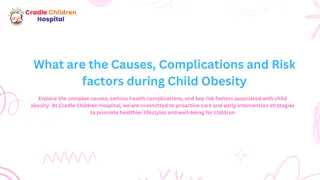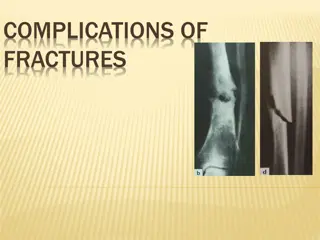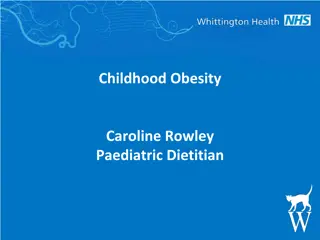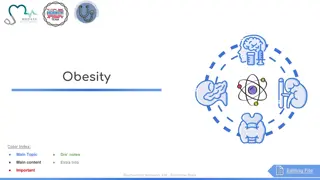Obesity: Symptoms, Causes, Risk Factors, Complications
Obesity is a complex disease involving excessive body fat, leading to risks of heart disease, diabetes, and more. Learn about symptoms, causes, risk factors, and treatment options for obesity.
Download Presentation

Please find below an Image/Link to download the presentation.
The content on the website is provided AS IS for your information and personal use only. It may not be sold, licensed, or shared on other websites without obtaining consent from the author.If you encounter any issues during the download, it is possible that the publisher has removed the file from their server.
You are allowed to download the files provided on this website for personal or commercial use, subject to the condition that they are used lawfully. All files are the property of their respective owners.
The content on the website is provided AS IS for your information and personal use only. It may not be sold, licensed, or shared on other websites without obtaining consent from the author.
E N D
Presentation Transcript
StudyMafia.Org Obesity Submitted To: Submitted By: Studymafia.org Studymafia.org
Table Contents Definition Introduction Symptoms of Obesity Causes of Obesity Risk-Factors of Obesity Complications of Obesity Diagnosis of Obesity Treatment of Obesity Conclusion 2
Definition Obesity is a complex disease involving an excessive amount of body fat. Obesity isn't just a cosmetic concern. 3
Introduction It's a medical problem that increases the risk of other diseases and health problems, such as heart disease, diabetes, high blood pressure and certain cancers. There are many reasons why some people have difficulty losing weight. Usually, obesity results from inherited, physiological and environmental factors, combined with diet, physical activity and exercise choices. 4
Causes of Obesity Although there are genetic, behavioral, metabolic and hormonal influences on body weight, obesity occurs when you take in more calories than you burn through normal daily activities and exercise. Your body stores these excess calories as fat. People with obesity might eat more calories before feeling full, feel hungry sooner, or eat more due to stress or anxiety. 7
Causes of Obesity Many people who live in Western countries now have jobs that are much less physically demanding, so they don't tend to burn as many calories at work. Even daily activities use fewer calories, courtesy of conveniences such as remote controls, escalators, online shopping and drive-through banks. 8
Risk-Factors of Obesity Family inheritance and influences 1. The genes you inherit from your parents may affect the amount of body fat you store, and where that fat is distributed. 2. Genetics may also play a role in how efficiently your body converts food into energy, how your body regulates your appetite and how your body burns calories during exercise. 9
Risk-Factors of Obesity Unhealthy diet. A diet that's high in calories, lacking in fruits and vegetables, full of fast food, and laden with high-calorie beverages and oversized portions contributes to weight gain. Liquid calories. People can drink many calories without feeling full, especially calories from alcohol. 10
Risk-Factors of Obesity Social and economic issues 1. Social and economic factors are linked to obesity. 2. Avoiding obesity is difficult if you don't have safe areas to walk or exercise. Similarly, you may not have been taught healthy ways of cooking, or you may not have access to healthier foods. 11
Risk-Factors of Obesity Age 1. Obesity can occur at any age, even in young children. But as you age, hormonal changes and a less active lifestyle increase your risk of obesity. 2. In addition, the amount of muscle in your body tends to decrease with age. Generally, lower muscle mass leads to a decrease in metabolism. 12
Risk-Factors of Obesity Other factors 1. Pregnancy. 2. Quitting smoking. 3. Lack of sleep. 4. Stress. 5. Microbiome. 13
Complicationsof Obesity Certain cancers. Obesity may increase the risk of cancer of the uterus, cervix, endometrium, ovary, breast, colon, rectum, esophagus, liver, gallbladder, pancreas, kidney and prostate. Digestive problems. Obesity increases the likelihood of developing heartburn, gallbladder disease and liver problems. 14
Complicationsof Obesity Sleep apnea. People with obesity are more likely to have sleep apnea, a potentially serious disorder in which breathing repeatedly stops and starts during sleep. Osteoarthritis. Obesity increases the stress placed on weight-bearing joints, in addition to promoting inflammation within the body. Severe COVID-19 symptoms 15
Diagnosis of Obesity Taking your health history. Your doctor may review your weight history, weight-loss efforts, physical activity and exercise habits, eating patterns and appetite control, what other conditions you've had, medications, stress levels, and other issues about your health. A general physical exam. This includes measuring your height; checking vital signs, such as heart rate, blood pressure and temperature; listening to your heart and lungs; and examining your abdomen. 16
Diagnosis of Obesity Calculating your BMI. Your doctor will check your body mass index (BMI). A BMI of 30 or higher is considered obesity Measuring your waist circumference. Fat stored around the waist, sometimes called visceral fat or abdominal fat, may further increase the risk of heart disease and diabetes. 17
Treatment of Obesity The goal of obesity treatment is to reach and stay at a healthy weight. Dietary changes Reducing calories and practicing healthier eating habits are vital to overcoming obesity. Although you may lose weight quickly at first, steady weight loss over the long term is considered the safest way to lose weight and the best way to keep it off permanently. 18
Treatment of Obesity Behavior changes A behavior modification program can help you make lifestyle changes and lose weight and keep it off. Steps to take include examining your current habits to find out what factors, stresses or situations may have contributed to your obesity. 19
Treatment of Obesity Weight-loss medication Weight-loss medications are meant to be used along with diet, exercise and behavior changes, not instead of them. Before selecting a medication for you, your doctor will consider your health history, as well as possible side effects. 20
Treatment of Obesity Weight-loss surgery Also known as bariatric surgery, weight-loss surgery limits the amount of food you're able to comfortably eat or decreases the absorption of food and calories. However, this can also result in nutritional and vitamin deficiencies. 21
Treatment of Obesity Exercise. People with obesity need to get at least 150 minutes a week of moderate- intensity physical activity to prevent further weight gain or to maintain the loss of a modest amount of weight. Keep moving. Even though regular aerobic exercise is the most efficient way to burn calories and shed excess weight, any extra movement helps burn calories. 22
Conclusion Obesity is a complex disease involving an excessive amount of body fat. Obesity isn't just a cosmetic concern. It's a medical problem that increases the risk of other diseases and health problems, such as heart disease, diabetes, high blood pressure and certain cancers. 24
References Google.com Wikipedia.org Studymafia.org Slidespanda.com
Thanks To StudyMafia.org























